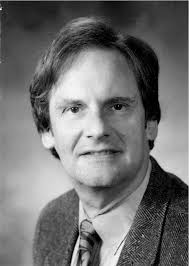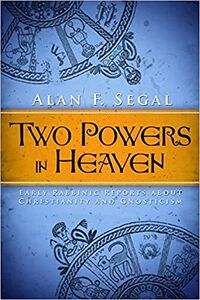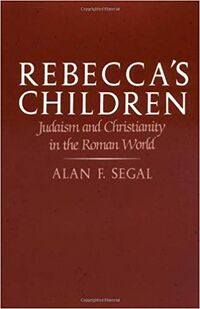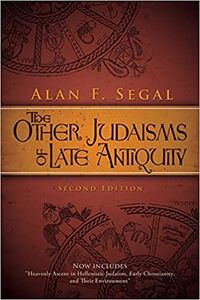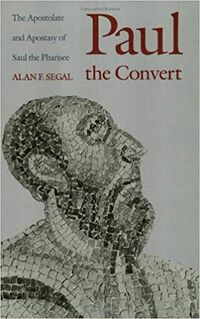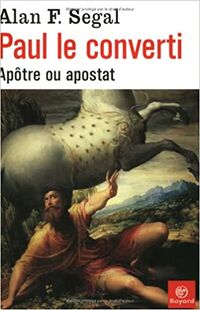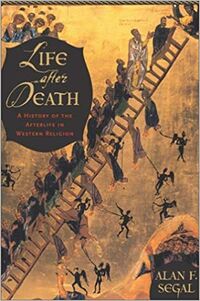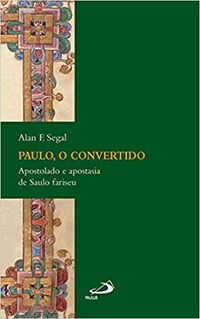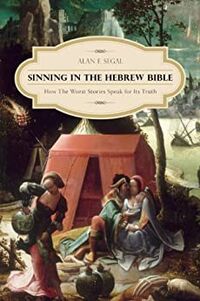Alan F. Segal (M / United States, 1945-2011), scholar
Jump to navigation
Jump to search
Alan F. Segal (1945-2011) was a Jewish-American scholar, at Columbia University (New York NY), USA. Alan F. Segal was born in Worcester, MA on August 2, 1945. He earned degrees from Amherst College (B.A., 1967), Brandeis University (M.A., 1969), Hebrew Union College-Jewish Institute of Religion (Bachelor of Hebrew Letters, 1971), and Yale University (M.A., 1971; M.Phil., 1973; and Ph.D., 1975). He joined the Faculty of Barnard College in 1980 as Professor of Religion and Ingeborg Rennert Professor of Jewish Studies. Alan F. Segal died on February 13, 2011.
-- 1970s --
Alan F. Segal, Two Powers in Heaven: Early Rabbinic Reports about Christianity and Gnosticism (Leiden: Brill, 1977)
- "In his now classic Two Powers in Heaven, Alan Segal examines rabbinic evidence about early manifestations of the "two powers" heresy within Judaism. Segal sheds light upon the development of and relationships among early Christianity, Gnosticism, and Merkabah mysticism and demonstrates that belief in the "two powers in heaven" was widespread by the first century, and may have been a catalyst for the Jewish rejection of early Christianity. An important addition to New Testament and Gnostic scholarship by this much revered scholar, Segal's Two Powers in Heaven is made available once again for a new generation."--Publisher description.
- "As the title suggests, Segal here explores the rabbinic heretics who believed in “two powers in heavens.” Using rabbinic and extra-rabbinic sources, he argues that the heresy originated in early biblical theophanies that pictured God as a man, such as Daniel 7:9, or confused YHWH with an angel. Later, he highlights how this heresy and the polemics leveled against it informed later rabbinic understandings of Christianity. Christians, like the rabbinic heretics who believed in “two powers in heaven,” also believed in two deities, God the Father and Christ the Logos. Consequently, the Rabbis deemed Christians not to be monotheists, leading to the split between the religions. An intriguing exploration in the history of religious developments, Segal's work also highlights the relationship between this belief system and later Jewish-Christian-Gnostic polemic."– Deborah Forger, University of Michigan
- Contents : Part One: Introduction -- 1. Two Powers in Heaven: The History and Importance of the Problem -- Part Two: The Early Rabbinic Evidence -- 2. Conflicting Appearances of God -- 3. Aher, Metatron, Merkabah, and the Angel of YHWH -- 4. A Controversy between Ishmael and Akiba -- 5. Midrashic Warnings Against "Two Powers -- 6. Mishnaic Prohibitions against Unorthdox Prayer -- 7. "Many Powers in Heaven" and Miscellaneous Repots -- 8. How Many Powers Created the World? -- 9. Divine Powers and Angels -- 10. Summary of Rabbinic Findings -- Part Three: The Extra Rabbinic Evidence and Conclusions -- 11. Philo -- 12. Jewish Sectarian Texts: a. Apocalypticism and Mysticism; b. New Testament Christianity -- 13. The Church Fathers -- 14. Marcion -- 15. Gnosticism -- 16. Conclusions
-- 1980s --
Alan F. Segal, Rebecca's Children: Judaism and Christianity in the Roman World (Cambridge, MA: Harvard University Press, 1986)
- "Renowned scholar Alan F. Segal offers startlingly new insights into the origins of rabbinic Judaism and Christianity. These twin descendants of Hebrew heritage shared the same social, cultural, and ideological context, as well as the same minority status, in the first century of the common era ... Through skillful application of social science theories to ancient Western thought, including Judaism, Hellenism, early Christianity, and a host of other sectarian beliefs, Segal reinterprets some of the most important events of Jewish and Christian life in the Roman world. For example, he finds: ― That the concept of myth, as it related to covenant, was a central force of Jewish life. The Torah was the embodiment of covenant both for Jews living in exile and for the Jewish community in Israel. ― That the Torah legitimated all native institutions at the time of Jesus, even though the Temple, Sanhedrin, and Synagogue, as well as the concepts of messiah and resurrection, were profoundly affected by Hellenism. Both rabbinic Judaism and Christianity necessarily relied on the Torah to authenticate their claim on Jewish life. ― That the unique cohesion of early Christianity, assuring its phenomenal success in the Hellenistic world, was assisted by the Jewish practices of apocalypticism, conversion, and rejection of civic ritual. ― That the concept of acculturation clarifies the Maccabean revolt, the rise of Christianity, and the emergence of rabbinic Judaism. ― That contemporary models of revolution point to the place of Jesus as a radical. ― That early rabbinism grew out of the attempts of middle-class Pharisees to reach a higher sacred status in Judea while at the same time maintaining their cohesion through ritual purity. ― That the dispute between Judaism and Christianity reflects a class conflict over the meaning of covenant ... The rising turmoil between Jews and Christians affected the development of both rabbinic Judaism and Christianity, as each tried to preserve the partly destroyed culture of Judea by becoming a religion. Both attempted to take the best of Judean and Hellenistic society without giving up the essential aspects of Israelite life. Both spiritualized old national symbols of the covenant and practices that consolidated power after the disastrous wars with Rome. The separation between Judaism and Christianity, sealed in magic, monotheism, law, and universalism, fractured what remained of the shared symbolic life of Judea, leaving Judaism and Christianity to fulfill the biblical demands of their god in entirely different ways."--Publisher description.
- "Using the biblical metaphor of the struggle of Rebecca’s twin children—Jacob and Esau—in the womb, Segal argues that the time of Jesus marks the beginning of not just one, but two religions: Judaism and Christianity. In the first half of the book, Segal sets the stage for this argument by first identifying “covenant” as Israel’s root metaphor (chapter 1), 2) then describing the diverse Jewish society that existed during Jesus’ day (chapter 2), and finally envisioning Jesus as the leader of an apocalyptic sectarian movement within Judaism. The later half of the book shows how the division between the religions occurred. Segal first contrasts the importance of Paul’s conversion for later Christianity (chapter four) with Rabbinic Judaism’s attention to ritual purity and personal piety (chapter five) to show how both Christianity and Rabbinic Judaism reflected an evolutionary step forward in religion in the midst of a complex and changing world. In the final two chapters, Segal underscores the parting of the ways between the religions, by highlighting the suspicious attitudes both religions had to one another (chapter six) and then contrasting the divergent theologies, which each religion developed to substantiate its claim to existence (chapter seven). Segal’s work should be commended for its innovative perspective on the relationship between the two religions. For Segal, like Neusner, though Judaism and Christianity were like “twins in Rebecca’s womb,” it is difficult to know which one is older than the other. The two religions grew, developed, and matured in relationship to one another."-–Deborah Forger, University of Michigan
- Contents : I. Israel between empires -- II. Society in the time of Jesus -- III. Jesus, the Jewish revolutionary -- IV. Paul, the convert and apostle -- V. Origins of the rabbinic movement -- VI. Communities in conflict -- VII. The ways divide.
Alan F. Segal, The Other Judaisms of Late Antiquity (Atlanta, GA: Scholars Press, 1987)
- "In The Other Judaisms of Late Antiquity the late Alan F. Segal is at his very best. This reissued and expanded edition―now containing his celebrated "Heavenly Ascent in Hellenistic Judaism, Early Christianity, and Their Environment"―delineates the variegated nature of both Judaism and Christianity in their formative periods. As Segal demonstrates, it is more accurate to speak of Judaisms and Christianities. Through his deft deployment of social-scientific methods and due attention to Jewish primary sources from the Second Temple period, Segal is able to trace the intricate, internecine struggles among Jewish, Christian, and gnostic communities in the earliest days of the Common Era. In doing so, Segal masterfully validates the importance of inductive historical reconstruction and analytical comparative study for illuminating the complex religious world of the first three centuries."--Publisher description.
-- 1990s --
Alan F. Segal, Paul the Convert (New Haven, CT: Yale University Press, 1990) =
- "The author argues that the best way to understand Paul is by using the conversion language prevalent in the first century. Largely reacting to the writings of Krister Stendahl and E.P. Sanders, Segal writes that Paul did in fact undergo a conversion. This conversion was not an emotional or crisic experience, but was demonstrated in Paul's willing change of social setting. So Paul then, a Jew, lives as a non-observant in a Gentile community. Segal uses this distinction to explain the struggle that Paul had with opponents in his letters. While Segal finds that conversions did occur in the first century, Paul's problems started in earnest when he tried to reconcile the observant and non-observant wings of the church. Segal's thesis is that Jews supported the idea of converting Gentiles, but were repulsed by non-observant Gentiles and observant Jews worshipping together."--Publisher description.
- "Although Paul’s writings have been intensively studied by Christian theologians, they have been dismissed by Jewish scholars as the meditations of an antagonistic apostate who broke completely with his Jewish past. In this revisionist account of Paul’s work, Alan Segal argues that Paul’s life can be better understood by taking his Jewishness seriously, and that Jewish history can be illuminated greatly by examining Paul’s writings. By reading Paul from the viewpoint of the religion he left behind, Segal sheds new light on the man who played a critical role in both Judaism and Christianity. "Segal’s new book challenges Jewish and Christian scholars alike to take a fresh look at this well-educated man."―-The Washington Post Book World
- "Segal has written a blockbuster of a book about Paul that blazes a new trail. It not only gives new insights into Paul and his thought, but it establishes the writings of Paul as significant primary source material for the study of first-century Judaism.."―Hayim Goren Perelmuter, New Theology Review
- "A brilliantly argued book. . . . Paul is neither hero nor villain for Segal but a fascinating historical and religious character, from whom we can learn much about both Judaism and Christianity. . . . I found myself thoroughly sympathetic to Segal’s portrayal of Paul. More than that, I found myself convinced."―J. Christian Wilson, The Christian Century
- "Paul the Convert is a stunning achievement. Segal brilliantly weaves together Jewish studies, New Testament scholarship, and contemporary social scientific theories of conversion into a richly textured and provocative book."―Lewis R. Rambo, Professor of Psychology and Religion, San Francisco Theological Seminary "This is by far the best book about Paul I have ever read: it revolutionizes Pauline studies. . . . Segal has made Paul, and early Christianity, more understandable and therefore deserves the heartfelt thanks of all believers and unbelievers."―Giles Quispel, Vigiliae Christianae
-- 2000s --
Alan F. Segal, Paul le converti: apôtre ou apostat, tr. Anne Paumier, Patrice Ghirardi, and Jean-François Sené (Paris, France: Bayard, 2003) <French ed.> <France>
- "Paul est rarement lu de façon sérieuse par les historiens juifs, car il provoque la colère des juifs d'aujourd'hui tout comme il provoquait celle de ses contemporains juifs et chrétiens. Son expérience du Christ dans ses visions, même si le Christ ne lui apparut jamais en chair et en os, rendit également son apostolat suspect aux yeux des apôtres. Pourtant, les méditations de Paul sur la signification du Christ devinrent, en Occident, le fondement des interprétations des intentions de Jésus, au même titre au moins que celles de ses disciples directs. La plupart des chercheurs considèrent qu'après la conversion, les écrits de Paul perdent toute pertinence pour le judaïsme. Il n'en est rien : Paul écrit à une communauté chrétienne toute nouvelle et qui est encore juive pour l'essentiel ; il nous apporte ainsi le seul témoignage d'un monde aujourd'hui disparu, celui du judaïsme hellénistique au quotidien. L'histoire, après Paul, a considéré que le christianisme était différent du judaïsme. Ce fait qui semble indéniable aujourd'hui n'était guère évident au Ier siècle. Paul se serait opposé avec force à toute distinction entre sa foi et son judaïsme, car il ne cessa de prêcher l'unité en Christ des juifs et des chrétiens. Pourtant, le fait que Paul ait réuni juifs et gentils dans sa communauté fut, par une étrange ironie, un pas décisif vers la séparation du judaïsme et du christianisme. Cependant l'étude de Paul est un apport essentiel à l'histoire juive. En effet, malgré la complexité de ses sentiments à l'égard du judaïsme et la singularité de son point de vue chrétien, Paul est une des sources les plus riches et les plus fiables pour notre connaissance de la vie religieuse juive au Ier siècle."--Publisher description.
Alan F. Segal, Life After Death: The Afterlife in Western Religions (New York, NY: Doubleday, 2004)
- "A magisterial work of social history, Life After Death illuminates the many different ways ancient civilizations grappled with the question of what exactly happens to us after we die ... In a masterful exploration of how Western civilizations have defined the afterlife, Alan F. Segal weaves together biblical and literary scholarship, sociology, history, and philosophy. A renowned scholar, Segal examines the maps of the afterlife found in Western religious texts and reveals not only what various cultures believed but how their notions reflected their societies’ realities and ideals, and why those beliefs changed over time. He maintains that the afterlife is the mirror in which a society arranges its concept of the self. The composition process for Judaism, Christianity, and Islam begins in grief and ends in the victory of the self over death ... Arguing that in every religious tradition the afterlife represents the ultimate reward for the good, Segal combines historical and anthropological data with insights gleaned from religious and philosophical writings to explain the following mysteries: why the Egyptians insisted on an afterlife in heaven, while the body was embalmed in a tomb on earth; why the Babylonians viewed the dead as living in underground prisons; why the Hebrews remained silent about life after death during the period of the First Temple, yet embraced it in the Second Temple period (534 B.C.E. –70 C.E.); and why Christianity placed the afterlife in the center of its belief system. He discusses the inner dialogues and arguments within Judaism and Christianity, showing the underlying dynamic behind them, as well as the ideas that mark the differences between the two religions. In a thoughtful examination of the influence of biblical views of heaven and martyrdom on Islamic beliefs, he offers a fascinating perspective on the current troubling rise of Islamic fundamentalism ... In tracing the organic, historical relationships between sacred texts and communities of belief and comparing the visions of life after death that have emerged throughout history, Segal sheds a bright, revealing light on the intimate connections between notions of the afterlife, the societies that produced them, and the individual’s search for the ultimate meaning of life on earth."--Publisher description.
- Contents : Introduction: The undiscover'd country -- 1. The climate of immortality. Egypt -- Mesopotamia and Canaan -- The First Temple Period in Israel -- 2. From climate to the self. Iranian views of the afterlife and ascent to the heavens -- Greek and classical views of life after death and ascent to the heavens -- Second Temple Judaism : the rise of a beatific afterlife in the Bible -- 3. Visions of resurrection and the immortality of the soul. Apocalypticism and millenarianism: the social backgrounds to the martyrdoms in Daniel and Qumran -- Religiously interpreted states of consciousness : prophecy, self-consciousness, and life after death -- Sectarian life in New Testament times -- 4. The path to modern views of the afterlife. Paul's vision of the afterlife -- The Gospels in contrast to Paul's writings -- The pseudepigraphic literature -- The Church Fathers and their opponents -- The early rabbis -- Islam and the afterlife: Muslim, Christian, and Jewish fundamentalism -- Afterword: Immortal longings.
-- 2010s --
Alan F. Segal, Paulo, o convertido (Sao Paulo, Brazil: Paulus Editora, 2010) <Portuguese ed.>
- "Embora os escritos de Paulo tenham sido intensamente estudados por teólogos cristãos, eles têm sido rejeitados por estudantes do Judaísmo como as meditações de um apóstata antagonista que rompeu completamente com seu passado judaico. Nessa abordagem revisionista da obra de Paulo, Alan Segal argumenta que a vida de Paulo pode ser mais bem compreendida ao se considerar seriamente sua qualidade judaica, e que a história judaica pode ser grandemente iluminada pelo exame dos escritos de Paulo. Ao ler Paulo do ponto de vista da religião que este abandonou, Segal derrama nova luz sobre o homem cujo papel foi decisivo tanto no Judaísmo como no Cristianismo."--Publisher description.
Alan F. Segal, Sinning in the Hebrew Bible: How the Worst Stories Speak for Its Truth
- "Stories of rape, murder, adultery, and conquest raise crucial issues in the Hebrew Bible, and their interpretation helps societies form their religious and moral beliefs. From the sacrifice of Isaac to the adultery of David, narratives of sin engender vivid analysis and debate, powering the myths that form the basis of the religious covenant, or the relationship between a people and their God ... Rereading these stories in their different forms and varying contexts, Alan F. Segal demonstrates the significance of sinning throughout history and today. Drawing on literary and historical theory, as well as research in the social sciences, he explores the motivation for creating sin stories, their prevalence in the Hebrew Bible, and their possible meaning to Israelite readers and listeners. After introducing the basics of his approach and outlining several hermeneutical concepts, Segal conducts seven linked studies of specific narratives, using character and text to clarify problematic terms such as "myth," "typology," and "orality." Following the reappearance and reinterpretation of these narratives in later compositions, he proves their lasting power in the mythology of Israel and the encapsulation of universal, perennially relevant themes. Segal ultimately positions the Hebrew Bible as a foundational moral text and a history book, offering uncommon insights into the dating of biblical events and the intentions of biblical authors."--Publisher description.
Biography
Categories:
- Scholars
- Second Temple Scholars & Authors
- Second Temple Scholars & Authors--American
- Second Temple Scholars & Authors--Jewish
- Pauline Scholars & Authors
- Pauline Scholars & Authors--American
- Pauline Scholars & Authors--Jewish
- American
- American Scholars
- Jewish-American
- Jewish-American Scholars
- Jewish
- Jewish Scholars
- Born in the 1940s
- Died in the 2010s
